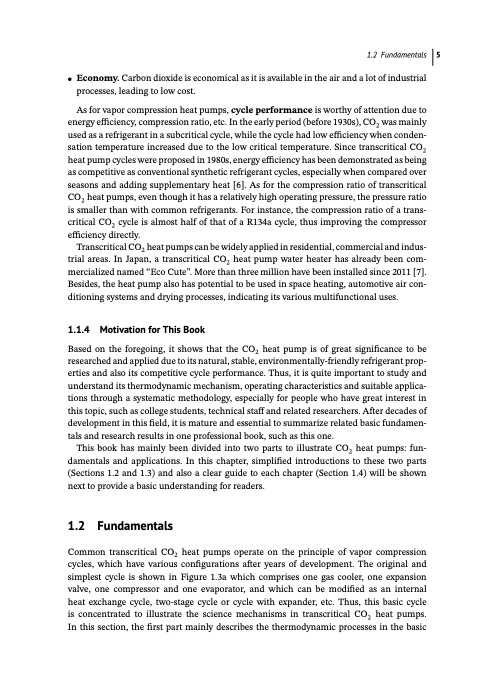
PDF Publication Title:
Text from PDF Page: 021
1.2 Fundamentals 5 ● Economy. Carbon dioxide is economical as it is available in the air and a lot of industrial processes, leading to low cost. As for vapor compression heat pumps, cycle performance is worthy of attention due to energy efficiency, compression ratio, etc. In the early period (before 1930s), CO2 was mainly used as a refrigerant in a subcritical cycle, while the cycle had low efficiency when conden- sation temperature increased due to the low critical temperature. Since transcritical CO2 heat pump cycles were proposed in 1980s, energy efficiency has been demonstrated as being as competitive as conventional synthetic refrigerant cycles, especially when compared over seasons and adding supplementary heat [6]. As for the compression ratio of transcritical CO2 heat pumps, even though it has a relatively high operating pressure, the pressure ratio is smaller than with common refrigerants. For instance, the compression ratio of a trans- critical CO2 cycle is almost half of that of a R134a cycle, thus improving the compressor efficiency directly. Transcritical CO2 heat pumps can be widely applied in residential, commercial and indus- trial areas. In Japan, a transcritical CO2 heat pump water heater has already been com- mercialized named “Eco Cute”. More than three million have been installed since 2011 [7]. Besides, the heat pump also has potential to be used in space heating, automotive air con- ditioning systems and drying processes, indicating its various multifunctional uses. 1.1.4 Motivation for This Book Based on the foregoing, it shows that the CO2 heat pump is of great significance to be researched and applied due to its natural, stable, environmentally-friendly refrigerant prop- erties and also its competitive cycle performance. Thus, it is quite important to study and understand its thermodynamic mechanism, operating characteristics and suitable applica- tions through a systematic methodology, especially for people who have great interest in this topic, such as college students, technical staff and related researchers. After decades of development in this field, it is mature and essential to summarize related basic fundamen- tals and research results in one professional book, such as this one. This book has mainly been divided into two parts to illustrate CO2 heat pumps: fun- damentals and applications. In this chapter, simplified introductions to these two parts (Sections 1.2 and 1.3) and also a clear guide to each chapter (Section 1.4) will be shown next to provide a basic understanding for readers. 1.2 Fundamentals Common transcritical CO2 heat pumps operate on the principle of vapor compression cycles, which have various configurations after years of development. The original and simplest cycle is shown in Figure 1.3a which comprises one gas cooler, one expansion valve, one compressor and one evaporator, and which can be modified as an internal heat exchange cycle, two-stage cycle or cycle with expander, etc. Thus, this basic cycle is concentrated to illustrate the science mechanisms in transcritical CO2 heat pumps. In this section, the first part mainly describes the thermodynamic processes in the basicPDF Image | What is a heat pump

PDF Search Title:
What is a heat pumpOriginal File Name Searched:
L-G-0016174002-0052376109.pdfDIY PDF Search: Google It | Yahoo | Bing
CO2 Organic Rankine Cycle Experimenter Platform The supercritical CO2 phase change system is both a heat pump and organic rankine cycle which can be used for those purposes and as a supercritical extractor for advanced subcritical and supercritical extraction technology. Uses include producing nanoparticles, precious metal CO2 extraction, lithium battery recycling, and other applications... More Info
Heat Pumps CO2 ORC Heat Pump System Platform More Info
| CONTACT TEL: 608-238-6001 Email: greg@infinityturbine.com | RSS | AMP |